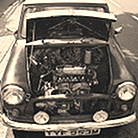|
Some folks just love to get under the hood, see what's going on in there. Others would just as soon not even know.

At Potlikker we don't demand or expect that you know or even care to know about all of this techno-mumbo-jumbo. But since it's our hobby, and since some clients have a real interest in the technical details, here is an attempt to catalog some of the many technologies we bring to bear to help you get what you want.
To the right is a brief run-down on the most common technologies we use. For more details, click the hyperlinked technologies and see the third column.
|
|
The following list includes some of the technologies that I've worked with:
- HTML - The basic markup language of the web.
- Cascading Style Sheets (CCS) - uses the 'stylesheet' concept with HTML
- JavaScript - the basic client-side scripting language that most websites use
- DHTML - a combination of client-side technologies that enable user-interactive display of page elements
- PHP - a free, well-supported server-side scripting language
- ASP - Microsoft's server-side scripting environment
- WordPress - Potlikker has set up and maintained several sites using the WordPress blogging engine, which is built using PHP
- Microsoft SharePoint 2007 (MOSS) and 2010 - more info coming soon
|
CSS (Cascading Style Sheets) is a way to give web pages style sheet functionality, long valued in the field of electronic publishing. Style sheets allow you to set and/or modify such aspects as text size, color, link characteristics, and line height in one, centralized location, thus greatly streamlining the task of changing styles throughout a page or website. CSS has great flexibility, allowing you to set styles either on a single page, in individual tags, or in an external file that may be referenced by numerous web pages.
CSS works by redefining the appearance of HTML tags and by creating classes or "IDs" that can be applied to any given tag. With the coming of CSS-P (CSS-Positioning), style sheet functionality expanded to such advanced considerations as visibility, absolute or relative position, and layering.
<Continue>
|

